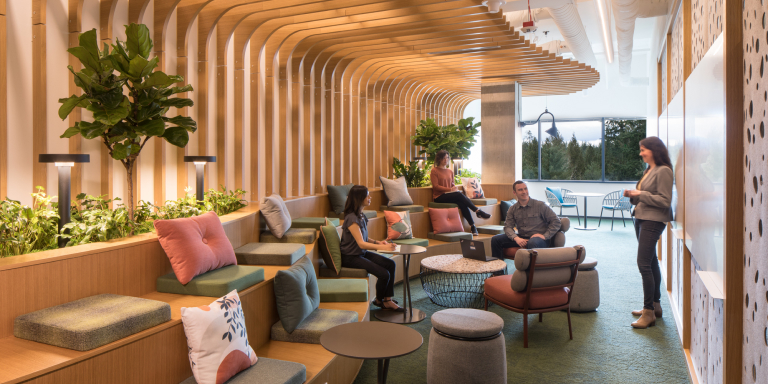The best part of your workday is your afternoon meditation.
You start your day by answering some emails, then go for a bike ride because the weather is gorgeous. You get back and take a quick shower, then sit down at your desk just in time for your first meeting of the day. (Your sweat pants are so much more comfortable than the circulation-cutting-off slacks you used to wear.) After some heads-down focus time, you take that daily meditation break before returning to the day’s most important tasks with renewed vigor.
Here’s the twist: you’re at the office.
This may sound like an inconceivable fantasy. But in the past two and a half years, many knowledge workers have taken advantage of unprecedented flexibility while working remotely. They’ve had more autonomy to schedule family obligations, exercise, errands—to schedule life. As workers across the world head back to the office all or part of the time, Jenna Butler, the lead researcher on the hybrid diaries study, has a radical proposal: What if we took the flexibility we’ve come to love in remote work back to the office? What if we weren’t confined to our desks from 9 to 5? What if we practiced yoga in the break room and took a nap in our ergonomic chair?
What if we didn’t go back to how it used to be?
The things that made people productive and happy when they were working at home can be brought to the office—but that transfer will necessitate a shift in policy, mindset, and norms. And the space itself needs to be designed with flexibility in mind . "It requires creating a culture where it’s understood that people might look different or be coming in at different hours, and that’s okay,” Butler says. "We need to let go of all of those long-held beliefs—that professionalism requires hard pants, that dedication is measured through hours at a desk—“because they haven’t been serving us.”

“The companies who embrace flexibility are going to have a better time retaining talent than those who say, ‘I own you from 9 to 5.’” —Chris Capossela, Microsoft executive vice president and chief marketing officer
According to Microsoft’s 2022 Work Trend Index, 80 percent of workers said they were just as or more productive since going remote or hybrid. At home, many of us have embraced a different rhythm to the day, taking time to pick up kids from school or running mid-morning errands. "What feels good as a person—to work when you feel like it, to take a break when you need to—that actually is better for the company,” Butler says, “because it improves productivity.” It’s also good for worker wellbeing. A famous study of British civil service workers found that employees in the lowest levels of government—those with the least control over their days—had higher stress and rates of illness than their counterparts above them on the hierarchy with more control.
But if you want to give more people more control over their days, you have to measure what those people produce in a different way. Many companies, Microsoft included, use the framework of objectives and key results, or OKRs , which focus on broad company goals tied to individual outcomes rather than the performative markers of productivity that once ruled the office. Think of it as measuring outputs versus inputs: Do you ultimately care about how many hours an employee worked, how many emails they sent? Or do you judge their work based on what they delivered: how many ads they sold, how many reports they wrote, and how influential they were?
“It’s really giving people trust from the outset,” says Mark Crowley, whose new book, Lead from the Heart , details how to inspire and manage your people in the post-pandemic era. Give employees goals and hold them accountable for their work, yes, but trust them to determine how and when they get that work done. “In my experience, the more trust you give them, the more they don’t want to lose it, and the more they will treat it as sacred.”
One of the top reasons people quit their jobs recently, according to Microsoft’s 2022 Work Trend Index, was a lack of flexibility. More than half of workers in a survey from professional services firm EY said they would resign if they weren’t given some form of flexibility at work.
“So much of this is actually giving people permission to step away. If you don’t do the norm part, then you fail.,”
“The companies who embrace flexibility are going to have a better time retaining talent than those who say, ‘I own you from 9 to 5,’” says Microsoft executive vice president and chief marketing officer Chris Capossela, who has championed flexible work at the company. “We’re a big believer that this is the right approach for not only retaining your best talent, but also for becoming a great place for your employees to work and thrive.”
He encourages companies to start by offering flex time, or a policy of allowing employees to set their own hours and step away to handle non-work errands as needed. This doesn’t work for every business—a restaurant server can’t run out for a massage while diners sit hungry. Instead, every company that employs frontline workers should ask what could be done to make their lives easier, as well as explore what policies and norms could be changed so they can benefit from increased flexibility, too. But in many workplaces, what would you really lose if an employee left at 3, as long as they consistently delivered quality work?
Businesses can also offer benefits that make it easy for people to integrate their lives into their workdays. Perhaps there’s a health club near the office for which you can provide discounts, or on-campus childcare to make after-school pickup easier for working parents. The key is to listen to what your employees value and determine what makes sense for them, then continue asking for feedback to figure out what’s working and change course as their needs evolve.
All flexible models require norms that are set by leaders, and part of that is about modeling the behavior from the top. “You’ve got to have the leaders of the company making it clear how they embrace flexibility,” Capossela says. When Microsoft gave every employee five bonus wellness days last year, Capossela not only used them all but made sure to share with his team that he’d taken some time to recharge. Setting those norms, he says, is more important than anything else, even that 10 percent discount at the health club. And creating them doesn't cost a penny. “So much of this is actually giving people permission to step away,” he says. “If you don’t do the norm part, then you fail.”
It’s making it okay for people to be a little sweaty in the conference room because they just went for a run, and not judging them for reading a few chapters of the new Kazuo Ishiguro after a morning of back-to-backs. It’s being happy that an employee can leave at 2 p.m. to pick up their kid from school, and trusting they’ll get their work done later in the day. It’s letting go of what we think the office is supposed to look like and embracing a new way of working, one that allows us to live richer, more full lives—meditation breaks and all.


